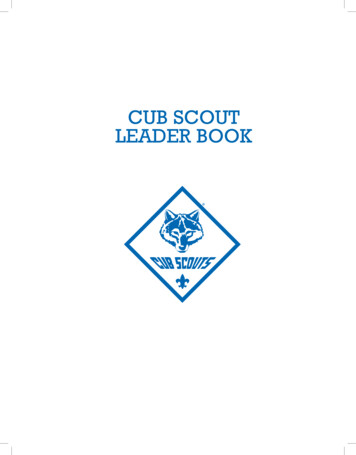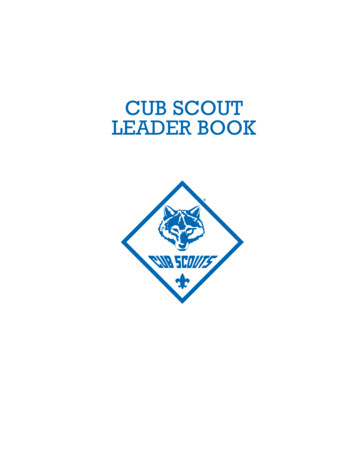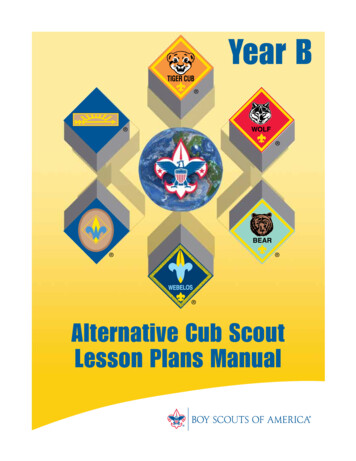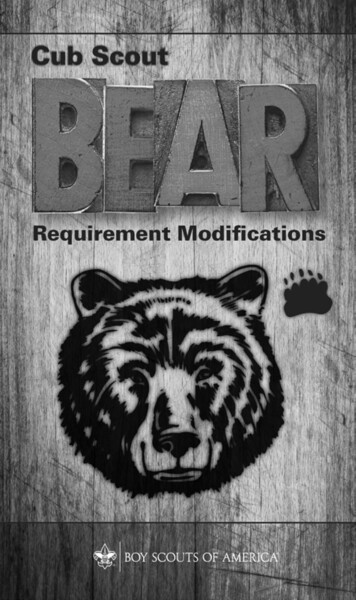
Transcription
Cub Incidents inthe U.S.The following is a partial list of incidentsinvolving cubs held captive by roadsidezoos and traveling zoos in the U.S. since2000. Animals are repeatedly bred sothat these enterprises have a constantsupply of cubs available to earn moneythrough “encounter” sessions and photoopportunities in which people pay tohold and be photographed with the cubs.Since cubs quickly grow to their adultsize, which can be as much as 700pounds for a tiger and 1,000 pounds ormore for bears, cubs can be used forphoto opportunities only during theirfirst few months of life, and they must betaken from their mother soon after birthin order to habituate them to humans.Some cubs never make it to adulthoodbecause of poor nutrition, illness,physical abuse, or neglect. As the cubsgrow larger, they become too dangerousto interact with the public. The oldercubs are replaced by younger ones andconfined to cages or sent to roadsidezoos. This cycle continually repeatsitself and, in the case of tigers,exacerbates the U.S. tiger crisis: Thereare far too many and not enoughresponsible facilities to take them.Contact PETA for documentation.March 23, 2020/Dade City, Florida: TheU.S. District Court for the Middle District ofFlorida entered a final judgment in PETA’sfavor in the Endangered Species Act (ESA)lawsuit filed in October 2016 against DadeCity’s Wild Things and its principals, KathyStearns and her son, Randy Stearns. Thejudgment established that the defendants’treatment of tigers—including prematurelyseparating tiger cubs from their mothers,{00224970}forcing tiger cubs to participate inencounters with the public, and caging themin substandard conditions—violated theESA. The court also issued a permanentinjunction banning Dade City’s Wild Thingsand Kathy and Randy Stearns from everowning or possessing tigers again andordered them to forfeit their tigers forplacement in reputable sanctuaries.November 13, 2019/Mooresville, NorthCarolina: The USDA cited Zootastic forfailing to handle a 6-month-old tiger namedSheldon as carefully as possible withminimal risk of harm to the animal and thepublic while exhibiting at the Sheldon’s K9sFall Festival on October 12, 2019. Videofootage from the event showed that the tigerremained lying on his or her side, pantingand mostly unresponsive to external activity.When stimulated, the tiger did not respondwith normal feline behavior. This may havebeen because of general exhaustion, heatexhaustion, and/or sedation, and exhibitingthe tiger in this condition could harm theanimal’s health and well-being. The tigerweighed approximately 50 pounds at thetime and was restrained by a harness andleash without sufficient physical barriers toprotect both the animal and the public.April 15, 2019/Newberry, Michigan: A 2year-old black bear named Sophie escapedfrom Oswald’s Bear Ranch during a poweroutage and was shot and killed by policeafter she approached an officer. Sophie wasraised around people at Oswald’s, whereshe was used for photo ops as a cub, andshe had come to expect food and treatsfrom them.October 23, 2018: As a result of a lawsuitthat PETA filed against Rick Pelphrey, aveterinarian who admitted to declawinglions, tigers, and big-cat hybrids illegally at aCharlestown, Indiana, roadside zoo namedWildlife in Need, a federal court order setthe precedent that declawing endangered
Tiger Cub Incidents in the United Statesand threatened big and exotic cats when notmedically necessary violates theEndangered Species Act (ESA). Pelphreyhad no specialized training to care for bigcats, and he declawed approximately 12 bigcats without giving them any painmedication over the previous three years atWildlife in Need. See March 17, 2017.July 25, 2017/Washington County,Oregon: The USDA cited exhibitor StevenHiggs for transporting a 2-week-old tigercub named Zarah. The cub had beentransported by car from Oklahoma toOregon. The USDA previously determinedthat neonatal cubs are unable tothermoregulate and lack fully functioningimmune systems. Higgs was previouslycited for transporting neonatal felids(bobcats) on May 23, 2016. Higgs was alsocited for failing to have the acquisitionrecord for Zarah available.June 7, 2017/Oroville, California: TheUSDA cited the Barry R. Kirshner WildlifeFoundation for failing to provide a lion cubnamed Lucie who was severely lame,uncomfortable, and unwilling to stand withadequate veterinary care. She was alsocited for a repeat violation for failing tofollow the diet plan correctly for this lion cub.She was giving the animal about 30 gramsof calcium gluconate daily, whereas thedose needed was actually 100 grams daily.March 17, 2017/Charlestown, Indiana:The USDA cited Wildlife in Need, Inc., forinterfering with its officials by repeatedlydenying that there were any other cubs onthe premises besides the two declawed lioncubs and one tiger cub the inspectors hadalready observed. After he was presentedwith evidence that the inspection team knewabout the animals, he finally admitted thatthere were two other tiger cubs. Headmitted that he had lied to the inspectionteam because the cubs had undergone a“botched” declaw procedure and that hewas “embarrassed” and didn’t want theteam to see them. He said that theprocedure had taken place approximatelytwo weeks earlier. He allowed the team toinspect the cubs but refused to allow aninspection of the room that they were keptin.The USDA also cited Stark for failing toprovide the two 5- to 6-week-old tiger cubswith adequate veterinary care. Their pawswere significantly swollen, and the animalswere spotting blood and struggling to walk.The cubs had been brought out for theinspection in a crate that was about 24inches long by 18 inches wide. They had tobe physically removed from it, and whenpersuaded to move, the orange cub wouldleave spots of blood from the front paws.The white tiger cub was severely lame anddragging a hind limb. This cub consistentlylay down and appeared to be sufferingthroughout the inspection. Stark was alsocited for failing to list these cubs in hisrecords—he had recorded only one cub’sbirth on February 10, 2017, instead of three.The inspector noted, “An orange and whitetiger cub were deliberately left off of therecords to provide false information toinspectors, as the licensee had advisedduring the inspection that the facility onlyhad 1 orange tiger born in 2017.” Starkeventually admitted that he had hidden thetwo cubs because he “did not want to getinto trouble for the veterinarian’s mistakes.”One of the cubs had a 50 percent chance ofdying because of complications from theprocedure, according to the attendingveterinarian.February 15, 2017/Dade City, Florida:The USDA issued a decision and order inresponse to the July 17, 2015, complaintthat the agency had filed against DadeCity’s Wild Things. The facility wasassessed a civil penalty of 21,000, issueda 60-day license suspension, and orderedto cease and desist violating the AWA,
Tiger Cub Incidents in the United Statesincluding by allowing the public to swim withtiger cubs. The order is stayed pending aruling on Dade City’s Wild Things’ appeal.July 20, 2016/Oroville, California: TheUSDA cited the Barry R. Kirshner WildlifeFoundation for failing to handle a male lioncub named Atlas properly. During a cubencounter, a member of the public held thelion without a harness or leash. A gate intothe facility that was approximately 130 feetfrom the exhibition, was left open. Accordingto the inspector, the lion cub was ofsufficient size and strength to harm amember of the public or escape.November 17, 2016/Troutman, NorthCarolina: The USDA issued Zootastic Parkof Lake Norman a penalty of 7,450 for nineviolations of the AWA, including for failing toprovide adequate veterinary care to a tigercub with significant swelling around hereyes, yellow ocular discharge, and patchesof hair loss.July 8, 2016/Charlestown, Indiana: TheUSDA filed an Animal Welfare Act (AWA)complaint against Stark and Wildlife in Needalleging over 110 willful violations of theAWA since 2012, including exposing tigercubs to rough and excessive handlingduring public encounters.July 5, 2016/Troutman, North Carolina:The USDA cited Zootastic Park of LakeNorman for failing to provide adequateveterinary care to a tiger cub with significantswelling around her eyes, yellow oculardischarge, and patches of hair loss. Thefacility was also cited for failing to haverecords of disposition for several tiger cubsavailable for inspection.June 13, 2016/Gentry, Arkansas: TheUSDA cited Wild Wilderness Drive-ThroughSafari for failing to have a public barrier foran enclosure holding five wolf hybrid cubswho were approximately 3 months old andfailing to have a park attendant present tomonitor the animals and park visitors.May 25, 2016/Kingwood, West Virginia:The USDA cited Hovatter’s Wildlife Zoo forfailing to feed 7-week-old lion cubs anutritionally adequate diet.May 19, 2016/Newberry, Michigan: Ahouseguest was scratched by a bear cubfrom Oswald’s Bear Ranch. The cub wasbeing cared for at the Oswalds’ privateresidence when the incident occurred. Thewound was treated after it became infectedtwo days later.March 24, 2016/Myrtle Beach, SouthCarolina: The USDA cited T.I.G.E.R.S.(The Institute of Greatly Endangered andRare Species), aka “Myrtle Beach Safari,”for failing to have a program of veterinarycare that addressed a recurring problem atthe facility—two white tiger cubs exhibitedringworm-like lesions. The agency noted theneed to address public-safety issues,including when the animals can have publiccontact.March 2, 2016/Massillon, Ohio: The OhioDepartment of Agriculture issued an orderplacing roadside zoo Stump Hill Farm underquarantine while it conducted aninvestigation into the facility’s alleged illegalpossession of dangerous wild animals. Theorder cited multiple instances in whichowner Cyndi Huntsman exported animals,including two tiger cubs, without a permit.February 1, 2016/Wynnewood,Oklahoma: The USDA cited G.W. Exotic forfailing to house three tiger cubs properly.One cub was 7 weeks old, and the othertwo were 12 weeks old. They were roamingunsupervised in a house at the rear of thepark, risking injury to themselves.December 18, 2015/Las Vegas, Nevada:FOX5 reported that two tiger cubs owned by
Tiger Cub Incidents in the United StatesSiegfried and Roy died from kidneyinfections. The cubs were housed atSiegfried and Roy’s Secret Garden andDolphin Habitat at the Mirage.November 17, 2015/Oroville, California:The USDA assessed Barry R. KirshnerWildlife Foundation a penalty of 5,464 forviolations of the AWA occurring betweenNovember 1, 2011, and August 1, 2014.These included allowing members of thepublic to come in direct contact with juvenilelions, and allowing a member of the publicto conduct a photo shoot with anunrestrained adult tiger and two tiger cubs.November 16, 2015/Wynnewood,Oklahoma: The USDA cited G.W. Exotic forfailing to provide tiger cubs with a safenursery area. Electrical outlets didn’t havecovers, exposing bare, live electrical wires,and two single-pane windows were lowenough that the cubs could potentially breakthem and escape.September 21, 2015/Okeechobee,Florida: The U.S. Department of Agriculture(USDA) cited exhibitor Sue Pearce forfailing to provide a tiger cub, who was foundinjured with a swollen neck and bite marks,with adequate veterinary care. Pearcecalled the attending veterinarian anddescribed the injuries, and the vetprescribed treatment over the phone withouthaving examined the cub. The cub’scondition deteriorated, and she died thefollowing day.September 13, 2015/Charlestown,Indiana: The USDA cited Wildlife in Need,Inc., for failing to handle tiger cubs properly.During “Tiger Playtime,” four 16-week-oldtiger cubs weighing 35 to 40 pounds wereallowed to interact with approximately 40 to50 members of the public. Two of the cubswalked into the public area after the gatewas opened, one cub who appeared to beasleep was dragged in by his front paws,and the fourth cub was pushed from behind.The cubs had no collars or leashes onthem, and the attendants used a riding cropto swat their noses if they started to bite.The inspector noted, “The cubs wereswatted frequently with the riding cropswhen the attendants were near them. Someof the swats were excessive in severitycausing the cubs obvious discomfort.”Members of the public, including an 8- or 9year-old girl, were bitten in at least twodifferent incidents.Wildlife in Need was also cited for usingthese cubs every day for months in multiplesessions without sufficient breaks inbetween. The inspector noted, “The fact thatthese cubs are allowing the attendants todrag them around by their front legs, nonresponsively, suggests they are exhaustedand have no choice but to cope with thesituation.” The cub who had been pulled intothe room was pulled to other areas duringthe 30-minute session. He remainedunresponsive and never stood. As thesession progressed, two other cubs laydown to nap and then were also draggedaround the room. At the end of the“playtime,” three of the cubs were draggedby their legs from the exhibit area, and theremaining awake cub was used for photoopportunities.September 9, 2015/Calhan, Colorado:The USDA cited roadside zoo SerenitySprings Wildlife Center for failing to supplyadequate veterinary care to a 7-week-oldtiger cub who suffered from crusted hair anddischarge from both eyes and was housedin an unsanitary enclosure with rodent fecesand exposed drywall. The facility was alsocited for failing to provide another sick tigercub with timely veterinary care. En route tothe veterinarian, the cub died from anunderlying immune-system deficiency.Serenity Springs received an additionalcitation for failing to follow a veterinarianapproved diet plan, which required that tiger
Tiger Cub Incidents in the United Statescubs receive calcium supplements. Twocubs were observed to have lameness andjoint swelling, possibly caused byinadequate calcium in their diets.August 27, 2015/Jamestown,Pennsylvania: The USDA cited roadsidezoo Pymatuning Deer Park for failing torecognize the abnormal behavior of two 5month-old bear cubs, which included pawand ear-sucking. When questioned, thefacility representative stated that all thehand-reared cubs exhibited this behaviorand that park officials didn’t recognize thatthis was an abnormal behavior pattern—asa result, this information had never beenconveyed to the attending veterinarian for itto be addressed. The facility was also citedfor failing to provide the two bear cubs withsufficient space to make normal “socialadjustments.” They were denied access to aback den area and kept on exhibit, whichconsisted of a concrete pad enclosure witha small pool and “toddler type plasticstructure.”August 19, 2015/Wynnewood, Oklahoma:The USDA cited G.W. Exotic for failing toprovide a 19-day-old tiger cub with asecondary heating or cooling method forclimate control while being exhibited at theMississippi Valley Fair in Iowa. Theinspector stated, “Animals this young in theabsence of their parents are not able toadequately thermoregulate and exposure totemperatures which may be comfortable foradults may still be detrimental to the healthof young cubs. Exposure to an excessivenumber of people and other animals at thisyoung age poses a disease risk to the cub.”August 5, 2015/Davenport, Iowa: Duringan inspection at the Mississippi Valley Fair,the USDA cited exhibitor Joe Schreibvogelfor improper handling of a 19-day-old tigercub who was being held alone, in view ofthe public, in a playpen-like enclosure withno secondary heating or cooling method forclimate control. The inspector noted,“Animals this young in the absence of theirparents are not able to adequatelythermoregulate and exposure totemperatures which may be comfortable foradults may still be detrimental to the healthof young cubs. Exposure to an excessivenumber of people and other animals at thisyoung age poses a disease risk to the cub.”August 4, 2015/Kingwood, West Virginia:The USDA cited roadside zoo Hovatter’sWildlife Zoo for failing to handle tiger cubsproperly. The cubs used in the facility’sphoto shoots were too large, too strong, andtoo aggressive to engage in direct contactwith the public. One tiger growled and usedhis claws to try to escape from the handlerwhen the animal was moved from his or hercage.August 1, 2015/Sussex, New Jersey:Space Farms Zoo ran an ad in the AnimalFinder’s Guide, a trade publication forexotic-animal breeders and dealers, offeringto sell or trade two male tiger cubs.July 27, 2015/Charlestown, Indiana: TheUSDA cited Wildlife in Need, Inc., for failingto feed four 10-week-old tiger cubs properly.They were still on a formula diet but shouldhave been provided meat starting at 2 to 3weeks of age, and the majority of their dietshould have been meat by 8 weeks of age.July 17, 2015/Dade City, Florida: TheUSDA filed a complaint against roadsidezoo Dade City’s Wild Things for 20 allegedviolations of the federal Animal Welfare Act(AWA), including four separate citations forfailing to handle young tigers as carefully aspossible in a manner that didn’t causebehavioral stress, physical harm, orunnecessary discomfort; two separatecitations for using physical abuse to handleyoung tigers, including pulling their tails torestrain them and holding a tiger aloft by hisneck; and two citations for “exposing young
Tiger Cub Incidents in the United Statesor immature tigers to rough or excessivehandling and/or exhibiting them for periodsof time that would be detrimental to theirhealth or well-being” and for “exhibitingyoung tigers for periods of time and/orunder conditions that were inconsistent withtheir good health and well-being.”June 4, 2015/Kingwood, West Virginia:The USDA cited Hovatter’s Wildlife Zoo forfailing to handle tiger cubs properly. Thecubs were pulled from their mother at birthand were cared for in the licensee’s home.At 2½ weeks old, they were used for publicencounters, and at 5 weeks old (at the timeof this inspection), the cubs had not beenvaccinated—putting them at risk since theydidn’t have fully developed immunesystems. Hovatter’s was also cited for failingto have a nutritionally adequate feeding planfor the cubs.May 23, 2015/Jamestown, Pennsylvania:The USDA cited roadside zoo PymatuningDeer Park for failing to have a veterinarianapproved diet plan to ease two 6-week-oldtiger cubs to solid food.May 19, 2015/Natural Bridge, Virginia:The USDA cited roadside zoo NaturalBridge Zoo for failing to feed tiger cubsproperly. Four cubs were born on April 9,2015, and removed from their mother withinone hour of birth. They were fed a diet thatwas inappropriate for their age and species.The one cub still remaining at the facilityhad a rough hair coat, prominent pelvis, andpot-bellied appearance.April 27, 2014/Melrose, Florida: A memberof the public who was allowed to hold a bearcub at Single Vision sustained a bite thatbroke the skin.April 27, 2014/St. Louis, Missouri: A 3month-old bear cub bit 14 WashingtonUniversity in St. Louis students. The cubhad been taken to the campus as part of apetting zoo owned by Cindy Farmer calledCindy’s Zoo. The bear was transferred tothe Saint Louis Zoo for a 30-dayobservation.April 8, 2015/Gentry, Arkansas: TheUSDA cited Wild Wilderness Drive-ThroughSafari for failing to handle lion cubsproperly. On October 22, 2014, a parkvisitor sought medical attention for an injuryreceived while participating in a parkallowed interaction with an uncontrolled 12week-old lion cub.January 6, 2015/Natural Bridge, Virginia:The USDA cited Natural Bridge Zoo forfailing to handle tiger cubs carefully. Thecubs were pulled from their mother at birthand put on display in the gift shop when 2 to3 weeks old. They were then used in photosessions when 3 to 4 weeks old, whichexposed them to the public before theywere immunocompetent. Natural Bridge Zoowas also cited for failing to handle tiger cubsproperly. In one case, a cub who was toobig and strong for direct public contact wasbeing used for photo opportunities.December 5, 2014/Massillon, Ohio: TheUSDA cited Stump Hill Farm for interferingwith an inspection by failing to report thepossession of a juvenile tiger. The inspectorasked the licensee multiple times in variousways about the presence of a juvenile tigeron the premises, and each time, thelicensee responded that there were noyoung or juvenile tigers on the property.However, the attending veterinarianconfirmed that his clinic had treated aninjured tiger cub, Lilly, a few days earlier.The inspector returned to the property andtold the licensee what he had learned. Sheconfirmed that there was a cub and that“she had ‘forgotten’ about this tiger becauseit was housed in another enclosure on theproperty which was located away fromwhere the other big cats were housed” inorder to reduce stress and contamination.
Tiger Cub Incidents in the United StatesThe inspector also questioned the licenseeabout a specific enclosure between onecontaining an adult lion and anothercontaining two adult tigers. The space in thefence was large enough for the big cats toinjure any animal in the middle enclosure,so the inspector asked the licensee ifanimals were ever placed in that enclosure.The licensee said no but later during theinspection admitted to putting the tiger cubLilly in there while staff cleaned herenclosure. Stump Hill was cited for placingLilly in the enclosure near the other big cats.She had been injured in her primaryenclosure, which resulted in a wound on herleg and the amputation of a toe. Thelicensee claimed that the injury occurredwhen Lilly got her paw stuck between metalpiping and chewed on her own paw and legin an attempt to free herself. Stump Hill wasalso cited for failing to have the record ofacquisition for Lilly at the time of theinspection.September 13, 2014/Calhan, Colorado:The USDA cited Serenity Springs WildlifeCenter for improperly handling an 8-weekold tiger cub by allowing the public to handlehim for at least six hours in one day with nodocumented breaks. During this long publicencounter, the cub uttered vocalizationsindicating distress numerous times.September 11, 2014/Tuttle, Oklahoma:The USDA cited roadside zoo Tiger Safarifor failing to supply adequate veterinarycare to a 16-week-old white tiger cub whohad skin lesions but had not been examinedby a veterinarian.August 19, 2014/Charlestown, Indiana:During a USDA inspection of roadside zooWildlife in Need, Inc., inspectors observedseveral incidents that took place during“Tiger Playtime,” when approximately 30members of the public sat in an enclosedarea and were allowed to interact freely withtwo tiger cubs. An attendee was pawed andmouthed in the face, one child was bitten onthe top of his thigh, another child wasgrabbed from behind and both sides of hisor her head and ears were mouthed by acub, and one of the inspectors was bitten onthe back, resulting in broken skin andbleeding.April 27, 2014/Melrose, Florida: A memberof the public who was allowed to hold a bearcub at Single Vision sustained a bite thatbroke the skin.April 27, 2014/St. Louis, Missouri: A 3month-old bear cub bit 14 WashingtonUniversity in St. Louis students. The cubhad been taken to the campus as part of apetting zoo owned by Cindy Farmer calledCindy’s Zoo. The bear was transferred tothe Saint Louis Zoo for a 30-dayobservation.August 11, 2014/Greensburg, Indiana:The USDA cited Stapp Circle S Ranch forimproper feeding of a 9-week-old tiger cub,who was fed only meat without additionalcalcium or vitamin supplements. Lack ofcalcium can lead to metabolic bone diseasein cubs and cause fractures and painfulbone conditions.April 3, 2014/Catskill, New York: TheUSDA cited roadside zoo Bailiwick Ranchfor failing to provide a brown bear cub withclean enrichment items, and failing toensure that ropes in the enclosure aren’t ahazard to the bear cub.March 18, 2014/Naples, Florida: TheUSDA cited exhibitor Patrick Clancy forfailing to feed a nutritionally complete dietand supply adequate veterinary care to atiger cub who was walking with a limp. Shewas being exhibited at the Collier CountyFair.March 10, 2014/Branson, Missouri: TheUSDA cited roadside zoo Promised Land
Tiger Cub Incidents in the United StatesZoo for failing to have an employee whohad been approved by the USDA for thecare and handling of exhibited big cats tooversee the adult lion and 7-week-old tigercub displayed at the facility.March 10, 2014/Miller, Missouri: TheUSDA cited Hostetler Wildlife Farms forfailing to provide tiger cubs with adequateveterinary care. Three cubs were born inJanuary, and according to the facilityrepresentative, one “got a little cold and themother may have sat on it.” The cub wasn’ttaken to a veterinarian. Hostetler was alsocited for improper handling of a tiger cubborn in mid-January who was transported toanother facility on January 31. This cub hadhealth concerns, including illness andpossible injury, from the date of his birth,and the facility representative at thedestination site stated that “there wassomething wrong with that cub.”January 17, 2014/Charlestown, Indiana:The USDA cited Wildlife in Need, Inc., forfailing to handle animals properly. The tigercubs used in the “Tiger Baby Playtime”event were approximately 15 to 16 weeksold. The licensee admitted that people hadbeen scratched and nipped during theexhibitions and that he told visitors to smackthe tigers on the nose if they got too rough.He said that some people didn’t hit thetigers hard enough and that if he needed tostep in, he would. The inspector noted thatthese cubs were “too large, too strong andaggressive” and that the licensee must stopusing them for direct-contact exhibitions.September 25, 2013/Naubinway,Michigan: The USDA cited roadside zooGarLyn Zoo for failing to have an employeewith experience or training in handling tigersin direct control of a tiger cub being used forpictures with the public.August 9, 2013/Denver, Colorado: Whileexhibiting at the Denver County Fair,Serenity Springs Wildlife Center was citedby the USDA for failing to restrain a 7-weekold tiger cub properly during a photo shootwith the public. The cub was vocalizing andsquirming, and the employee didn’t properlyhandle the cub in order to minimize the riskof harm to the animal and the public.June 11, 2013/Calhan, Colorado: TheUSDA noted on an inspection report for JoeSchreibvogel, operator of G.W. ExoticAnimal Memorial Foundation, that it wasreviewing an incident that involved thetransportation of two tiger cubs and theirsubsequent death on or around May 10,2013. (See May 23, 2013/Calhan,Colorado.)May 23, 2013/Calhan, Colorado: TheUSDA cited Serenity Springs Wildlife Centerfor failing to follow the attendingveterinarian’s instructions to monitor a tigerin labor, leading to the death of the tiger andthe single cub during birth. In addition, theUSDA cited Serenity Springs for failing tohandle two 3-day-old tiger cubs properly.They were acquired from another facility,and one died within 24 hours of arriving atSerenity Springs. Two days after arriving atSerenity Springs, the second cub wasunable to pass feces and was euthanized.May 6, 2013/Calhan, Colorado: The USDAcited Serenity Springs Wildlife Center for arepeat violation for failing to provide twolame tiger cubs with veterinary care. Duringan inspection to check the condition of atiger cub previously identified to be severelylame and unable to bear weight on his rightfront limb, the inspector observed that thecub had a severe limp, wouldn’t bear weighton his right hind leg, and had noticeableswelling of the ankle area. Another cub wasalso severely limping on his right hind legand had swelling around the ankle area.The cub would only hop a short distancebefore falling to the ground.
Tiger Cub Incidents in the United StatesApril 18, 2013/Calhan, Colorado: TheUSDA cited Serenity Springs Wildlife Centerfor a repeat violation for failing to provide atiger cub with adequate veterinary care. Thecub was previously observed to have asevere limp, and during this inspection, thelimp affecting the right front leg appeared tobe worse. The cub wouldn’t bear weight onthe paw and struggled to get to the fooddish in the enclosure.April 10, 2013/Calhan, Colorado: TheUSDA cited Serenity Springs Wildlife Centerfor failing to provide a tiger cub withadequate veterinary care. He was observedto have a severe limp affecting his right frontleg, causing him to stumble and fall onto hisshoulder. He was also seen walking with acrab-like posture with his hind legs andappeared to be in pain. This condition hadnot been noted by any of the staff membersor reported to the veterinarian.March 28, 2013/Troutman, NorthCarolina: The USDA cited roadside zooZootastic Park of Lake Norman for leaving adoor to a room in the gift shop housing alion cub unlocked and for improperlyhandling a white tiger cub weighingapproximately 40 pounds. A customer wasallowed to lie face-to-face on the floor withthe cub, who apparently bit the man on thenose.February 28, 2013/Litchfield Park,Arizona: The USDA cited roadside zooWildlife World Zoo for allowing a 3-monthold tiger cub to run through a local televisionstudio. The inspector noted that the cub wasseen biting the clothing of an offstagehandler while the lead handler was seenwith scratches and bite marks on his arms.The host of the television program was alsoseen pulling on the tiger’s tail.January 24, 2013/Chicago, Illinois: TheUSDA cited traveling exhibitor Jo-DonFarms for failing to have barriers in place toprotect a tiger cub and the public during aphoto event.October 23, 2012/Seattle, Washington:The USDA cited Steve Higgs for improperlyhandling a juvenile tiger. An onlooker wasable to get close enough to touch the tiger’sface.May 21, 2012/Wynnewood, Oklahoma:The USDA cited G.W. Exotic AnimalMemorial Foundation for improperlyhandling animals. The report stated that thefacility’s handling techniques were underreview.May 21, 2012/Wynnewood, Okla
Some cubs never make it to adulthood because of poor nutrition, illness, physical abuse, or neglect. As the cubs grow larger, they become too dangerous to interact with the public. The older cubs are replaced by younger ones and confined to cages or sent to roadside zoos. This cycle continually repeats itself and, in the case of tigers,










